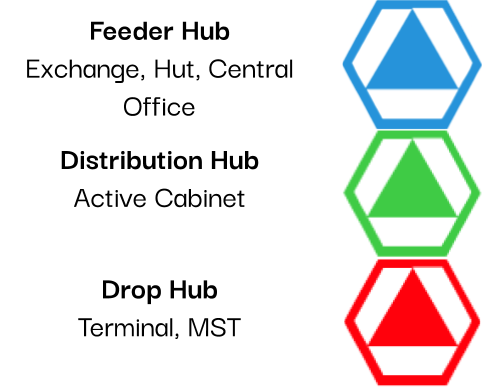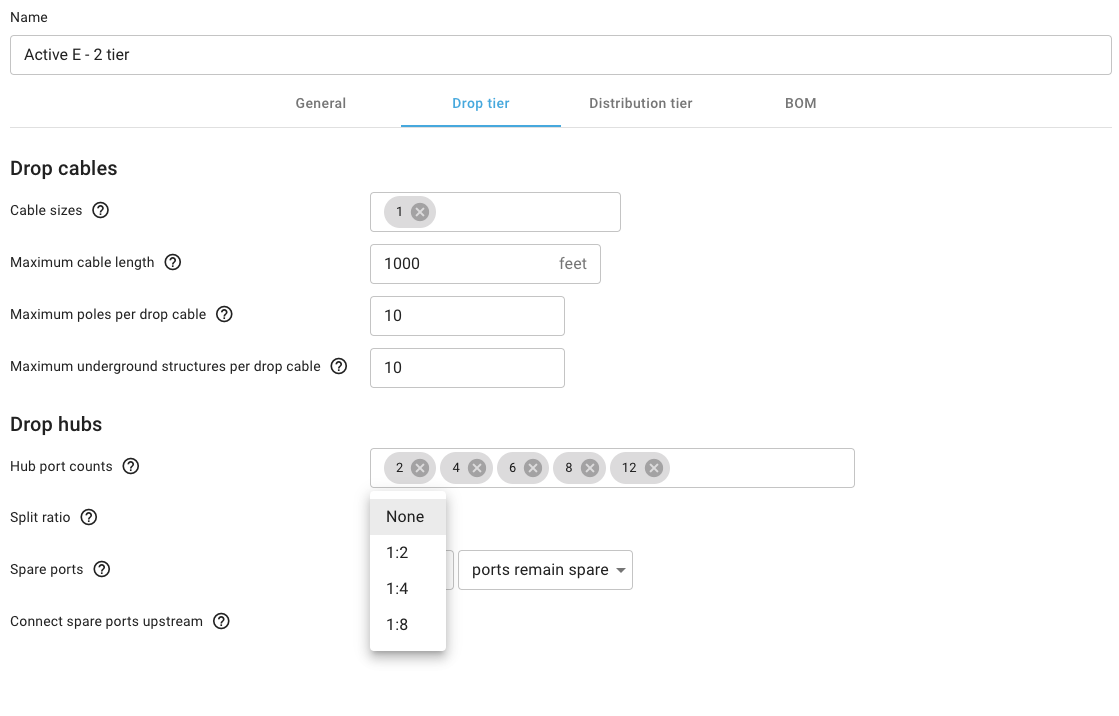How to create an Active Ethernet architecture
While FOND uses terminology that leans more towards PON networks, it can be used to effectively model Active E networks as well.
By the end of this article, you should understand:
- that while FOND uses terminology that's different to an Active E network, it can still be used to model it once you understand how the terminology relates to more generic concepts
- what parameters to use in the architecture panel
Terminology
Before diving into the details of Active ethernet design, let's review some terminology:
- Hub: FOND uses the term "Hub" in a generic sense. It's just any location that is an aggregation point for cables. A Drop Hub is the aggregation point for all the drop cables e.g an MST or Terminal, a Distribution Hub is a location that all Distribution cables come back to, and likewise, a Feeder Hub is the point that Feeder cables return to.
- Tiers: networks can be considered as a hierarchy where the lowest tier connects subscribers to the lowest tier Hub and the highest tier is the exchange or tie-in-point to a core network. FOND uses two or three tiers depending on what sort of network you'd like to produce. Both are valid when designing Active E networks
- Drop, Distribution, and Feeder: are the names that FOND gives to each tier of the network. The Drop tier connects homes via a drop cable to a Drop Hub (e.g MST, Terminal), the Distribution Tier from the Drop Hub to the next Hub in the Hierarchy, and then Feeder connects those hubs to the ones above them.
The diagram below shows how this terminology lines up with that used in Active E networks:

Parameters to use in the architecture panel
When designing an Active E network in FOND, you may only be concerned with the network between the Active Cabinets (Distribution Hub and the Drop Hub). In this case, you would select "2" for the number of tiers. If you wanted to model the way that these cabinets connect back to the Exchange, use 3 tiers but keep in mind that FOND doesn't design with cable diversity.

The next step is to configure the Drop tier:

The main thing with this tier is to ensure you've set the Split ratio to be None i.e no splitters are to be used. You should also set that Split ratio to None in the Distribution tier step in the workflow.

Make sure you set a high enough port count for the "Hub port counts" parameters which represents the maximum number of subscribers that you wish to be able to serve from that device. You can set multiple values if you have more than one size of cabinet in your inventory.

If you are looking to design back to the exchange, make sure you've selected "3" for the Number of tiers parameter back in the General step. The Feeder tier step will then appear:

In most cases, the default value of 10,000 is enough, but this represents the total number of subscribers you'd like to serve from your Exchange or Central office location.
Summary
With a better understanding of FOND's terminology, hopefully, you can see how an Active E network can be modeled in FOND. As always, if you need more help, the support team at fondhelp@biarrinetworks.com is always able to provide more assistance.